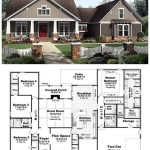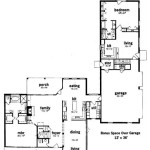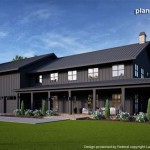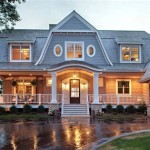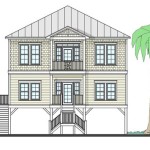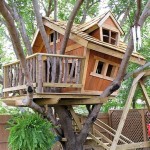Guest house plans refer to architectural blueprints specifically designed for the construction of guest housesseparate structures built on a property to accommodate visitors or extended family members. These structures provide additional living space and enhance the functionality of a primary residence, offering a private and comfortable retreat for guests.
Guest houses have become increasingly popular in recent years, offering a convenient solution for hosting overnight guests over extended periods. They provide a sense of independence and privacy for visitors while ensuring their comfort and well-being. Whether you intend to rent out the guest house or use it for personal purposes, carefully designed plans are essential to create a functional and aesthetically pleasing space.
In the following sections, we will delve into the intricacies of guest house plans, exploring various design considerations, types of plans, and factors to keep in mind when selecting the right plan for your needs. We will also discuss the benefits of having well-thought-out guest house plans and provide tips for maximizing the space and functionality of your guest house.
When selecting guest house plans, there are several key considerations to keep in mind. Here are ten important points to consider:
- Size and layout
- Number of bedrooms and bathrooms
- Kitchen facilities
- Living and dining areas
- Outdoor space
- Architectural style
- Energy efficiency
- Accessibility
- Budget
- Local building codes
By carefully considering these factors, you can choose guest house plans that meet your specific needs and create a comfortable and welcoming space for your guests.
Size and layout
The size and layout of your guest house will depend on your specific needs and the available space on your property. Consider the number of guests you typically host, the length of their stay, and the activities they will be engaged in.
- Overall square footage: The size of your guest house will impact its overall cost and functionality. Determine the minimum square footage required to comfortably accommodate your guests, considering sleeping arrangements, living space, and storage.
- Number of bedrooms and bathrooms: The number of bedrooms and bathrooms will depend on the size of your guest house and the number of guests you anticipate hosting. Consider providing at least one bedroom with an en-suite bathroom for added privacy and convenience.
- Kitchen facilities: Decide whether you want your guest house to have a fully equipped kitchen, a kitchenette, or no kitchen at all. A fully equipped kitchen provides maximum convenience for guests, while a kitchenette or no kitchen may be more suitable for shorter stays or guests who prefer to dine out.
- Living and dining areas: The living and dining areas should be designed to be comfortable and inviting. Consider the size of the space, the amount of natural light, and the furniture arrangements to create a welcoming atmosphere.
By carefully considering the size and layout of your guest house, you can create a space that meets the needs of your guests and complements your property.
Number of bedrooms and bathrooms
The number of bedrooms and bathrooms in your guest house will depend on the size of the space and the number of guests you anticipate hosting. Here are some key considerations:
Number of guests: Determine the maximum number of guests your guest house will accommodate. This will help you decide on the minimum number of bedrooms required.
Length of stay: Consider the typical length of stay for your guests. If they are likely to stay for extended periods, you may want to provide more bedrooms and bathrooms for added comfort and privacy.
Privacy and convenience: Providing at least one bedroom with an en-suite bathroom can enhance privacy and convenience for your guests. This is especially important if multiple guests will be sharing the space.
Space constraints: The available space on your property will also influence the number of bedrooms and bathrooms you can include in your guest house. Carefully consider the size and layout of the space to ensure that the guest house feels comfortable and spacious.
By carefully considering these factors, you can determine the optimal number of bedrooms and bathrooms for your guest house, ensuring a comfortable and welcoming space for your guests.
Kitchen facilities
The kitchen facilities in your guest house will depend on the size of the space, the length of stay for your guests, and your budget. Here are some key considerations:
Fully equipped kitchen: A fully equipped kitchen includes all the major appliances (refrigerator, stove, oven, microwave) as well as ample counter space, storage cabinets, and a sink. This option provides maximum convenience for guests who plan to cook meals during their stay.
Kitchenette: A kitchenette is a smaller, more compact kitchen that typically includes a sink, a mini-fridge, a microwave, and limited counter space. This option is suitable for shorter stays or for guests who prefer to dine out.
No kitchen: If your guest house is intended for short stays or if your guests are not likely to cook meals, you may opt for no kitchen at all. This can help save space and reduce the cost of construction.
Appliances: When selecting appliances for your guest house kitchen, consider the size of the space and the needs of your guests. Energy-efficient appliances can help reduce operating costs and minimize your environmental impact.
Countertops and storage: Durable and easy-to-clean countertops are essential for any kitchen. Provide ample storage cabinets and drawers to keep the kitchen organized and clutter-free.
Lighting and ventilation: Adequate lighting and ventilation are crucial for a functional and comfortable kitchen. Natural light is always preferable, but be sure to supplement with artificial lighting as needed. A range hood or exhaust fan is essential for removing cooking odors and fumes.
By carefully considering the kitchen facilities in your guest house plans, you can create a space that is both functional and inviting for your guests.
Living and dining areas
The living and dining areas in your guest house should be designed to be comfortable, inviting, and functional. Here are some key considerations:
- Size and layout: The size and layout of the living and dining areas will depend on the overall size of your guest house and the number of guests you anticipate hosting. Consider the flow of traffic between the two areas and ensure that there is enough space for guests to move around comfortably.
- Furniture: Choose furniture that is comfortable, durable, and easy to clean. Consider the size of the space and the number of guests you will be accommodating. A sofa, armchairs, and a coffee table are typically essential for a living area, while a dining table with chairs is necessary for a dining area.
- Lighting: Natural light is always preferable, but be sure to supplement with artificial lighting as needed. Provide a combination of overhead lighting and task lighting to create a warm and inviting atmosphere.
- Decor: The decor of the living and dining areas should complement the overall style of your guest house. Choose colors and patterns that create a welcoming and relaxing ambiance.
By carefully considering the living and dining areas in your guest house plans, you can create a space that is both comfortable and stylish, providing a relaxing and enjoyable retreat for your guests.
Outdoor space
The outdoor space associated with your guest house can significantly enhance the overall experience for your guests. Here are some key considerations:
Patio or deck: A patio or deck provides an outdoor living area where guests can relax, dine, or simply enjoy the fresh air. Consider the size and layout of the patio or deck, as well as the materials used for construction. Durable and low-maintenance materials such as composite decking or pavers are popular choices.
Landscaping: The landscaping around your guest house can create a welcoming and inviting atmosphere. Consider planting trees and shrubs to provide shade and privacy, and add colorful flowers and greenery to enhance the visual appeal. Outdoor lighting can also extend the usability of the outdoor space in the evenings.
Fire pit or outdoor fireplace: A fire pit or outdoor fireplace can create a cozy and inviting ambiance for guests to gather around and enjoy each other’s company. Consider the size and location of the fire pit or fireplace, as well as the safety regulations in your area.
Pool or spa: If your budget and space allow, a pool or spa can be a luxurious addition to your guest house. Consider the size, shape, and depth of the pool or spa, as well as the surrounding decking or patio area.
Privacy and security: Ensure that your guest house’s outdoor space provides a sense of privacy for your guests. Consider fencing or hedges to create a secluded area, and install outdoor lighting for safety and security.
By carefully considering the outdoor space in your guest house plans, you can create a space that is both functional and inviting, providing your guests with a relaxing and enjoyable retreat.
Architectural style
The architectural style of your guest house should complement the main house and the surrounding environment. Here are some popular architectural styles to consider:
- Traditional: Traditional architectural styles, such as Colonial, Victorian, and Craftsman, are characterized by their timeless appeal and classic features. They often feature symmetrical facades, pitched roofs, and decorative details.
- Modern: Modern architectural styles, such as Contemporary and Mid-Century Modern, emphasize clean lines, open spaces, and an abundance of natural light. They often feature flat roofs, large windows, and sleek finishes.
- Rustic: Rustic architectural styles, such as Log Cabin and Farmhouse, are characterized by their use of natural materials and a cozy, inviting atmosphere. They often feature exposed beams, stone fireplaces, and wood accents.
- Cottage: Cottage architectural styles, such as English Cottage and Cape Cod, are known for their charming and quaint appearance. They often feature steeply pitched roofs, dormer windows, and white picket fences.
The architectural style you choose should reflect your personal preferences and the overall aesthetic of your property. By carefully considering the architectural style of your guest house, you can create a cohesive and visually appealing design that complements your main house and enhances the overall enjoyment of your property.
Energy efficiency
Incorporating energy-efficient features into your guest house plans can significantly reduce operating costs and minimize your environmental impact. Here are some key considerations:
- Insulation: Proper insulation in the walls, roof, and floor of your guest house is crucial for maintaining a comfortable indoor temperature while reducing energy consumption. Consider using high-performance insulation materials such as cellulose, fiberglass, or spray foam to minimize heat transfer.
- Windows and doors: Energy-efficient windows and doors can significantly reduce heat loss and gain. Look for windows with double or triple glazing, low-emissivity coatings, and tight seals to minimize air leakage. Similarly, choose doors with weatherstripping and insulated cores to prevent drafts.
- Lighting: Energy-efficient lighting fixtures, such as LED bulbs, use significantly less energy than traditional incandescent bulbs while providing comparable or better illumination. Consider installing dimmers or motion sensors to further reduce energy consumption.
- Appliances: When selecting appliances for your guest house, choose Energy Star-rated models that meet strict energy efficiency standards. Energy-efficient appliances consume less energy, which can result in lower utility bills and a reduced carbon footprint.
By incorporating these energy-efficient features into your guest house plans, you can create a space that is both comfortable and environmentally friendly, reducing your operating costs and contributing to a more sustainable future.
Accessibility
Accessibility considerations are essential in guest house plans to ensure that the space is welcoming and comfortable for all guests, regardless of their abilities or disabilities. Here are some key points to consider:
Universal design: Universal design principles aim to create spaces that are accessible and usable by people of all ages and abilities. Incorporating universal design features into your guest house plans, such as wider doorways, ramps instead of stairs, and accessible bathrooms, can make the space more inclusive and enjoyable for all.
Mobility assistance: If your guest house is likely to accommodate guests with limited mobility, consider providing mobility assistance features such as grab bars in bathrooms, roll-in showers, and accessible kitchen appliances. These features can enhance the safety and comfort of guests with disabilities.
Sensory considerations: Guests with sensory sensitivities may benefit from features such as dimmable lighting, noise-reducing flooring, and visual aids like large print labels. Providing these sensory considerations can create a more comfortable and welcoming environment for all guests.
Emergency access: Ensure that your guest house plans include clear and accessible emergency exits. Emergency exits should be well-marked and free of obstacles, and consider providing emergency call buttons or other communication devices for guests with disabilities.
By incorporating accessibility considerations into your guest house plans, you can create an inclusive and comfortable space that welcomes guests of all abilities, enhancing their overall experience and ensuring that everyone feels valued and respected.
Budget
Establishing a realistic budget is crucial before embarking on your guest house project. The overall cost will vary depending on several factors, including the size and complexity of the design, the materials used, and the cost of labor in your area. Here are some key considerations:
Size and complexity: Larger guest houses with intricate designs and multiple rooms will naturally require a higher budget. Consider the square footage, number of bedrooms and bathrooms, and any special features or amenities you desire.
Materials: The choice of materials for the exterior and interior of your guest house will significantly impact the cost. Higher-quality materials, such as natural stone, hardwood flooring, and designer fixtures, will increase the overall expense compared to more budget-friendly options.
Labor costs: The cost of labor will vary depending on your location and the availability of skilled contractors in your area. It is advisable to obtain quotes from multiple contractors to compare pricing and ensure you are getting a fair deal.
Contingency fund: It is prudent to allocate a contingency fund of approximately 10-15% of your total budget to cover unexpected expenses or unforeseen circumstances that may arise during the construction process.
By carefully considering these factors and planning a realistic budget, you can avoid financial surprises and ensure your guest house project stays on track and within your means.
Local building codes
Local building codes are regulations established by municipalities to ensure the safety and habitability of buildings within their jurisdiction. These codes cover various aspects of construction, including structural integrity, fire safety, energy efficiency, and accessibility. When planning your guest house, it is essential to familiarize yourself with the local building codes that apply to your area.
Building codes are typically enforced through a permitting process. Before commencing construction, you will need to obtain a building permit from your local building department. To obtain a permit, you will need to submit plans for your guest house that demonstrate compliance with the relevant building codes. The building department will review your plans and issue a permit if they meet the code requirements.
Local building codes can vary significantly from one municipality to another. Some common requirements that you may encounter include:
- Setbacks: Setbacks are the minimum distances that a building must be set back from property lines and other structures. These setbacks help to ensure adequate lighting, ventilation, and fire safety.
- Height restrictions: Height restrictions limit the maximum height of buildings within a particular area. These restrictions are typically in place to maintain the character of a neighborhood or to prevent obstruction of views.
- Structural requirements: Structural requirements specify the minimum standards for the structural integrity of buildings. These requirements are designed to ensure that buildings can withstand the forces of nature, such as wind, snow, and earthquakes.
- Fire safety requirements: Fire safety requirements aim to minimize the risk of fires and to provide safe egress in the event of a fire. These requirements may include the use of fire-resistant materials, the installation of smoke detectors and fire sprinklers, and the provision of adequate exits.
By adhering to local building codes, you can ensure that your guest house is safe, habitable, and compliant with the law. Failure to comply with building codes can result in delays, fines, or even the inability to obtain a building permit. Therefore, it is crucial to consult with your local building department early in the planning process to determine the specific requirements that apply to your project.










Related Posts

